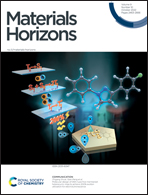Understanding the charge dynamics in organic light-emitting diodes using convolutional neural network†
Abstract
Knowledge about the charge dynamics in organic light-emitting diodes (OLEDs) is a critical clue to optimize device architecture for enhancing the power efficiency and driving voltage characteristics in addition to the external quantum efficiency. In this work, we demonstrated that the charge behavior according to the operation voltage of OLEDs could be understood by introducing the convolutional neural network (CNN) of the machine learning framework without additional analysis of the unipolar charge devices. The CNN model trained using a two-dimensional (2D) modulus fingerprint simultaneously predicted the mobilities of the charge transport and emitting layers, realizing a deep understanding of the complicated data that humans cannot interpret. The machine learning model successfully describes the electrical properties of the organic layers in the actual devices configurated by different electron-transporting materials and the composition of cohosts in the emitting layer. For the first time, it was revealed that 2D fingerprints extracted using frequency- and voltage-dependent modulus spectra were effective data to represent comprehensive charge dynamics of OLEDs. The interpretation and perspective of the machine learning approach in this work were also discussed.



 Please wait while we load your content...
Please wait while we load your content...